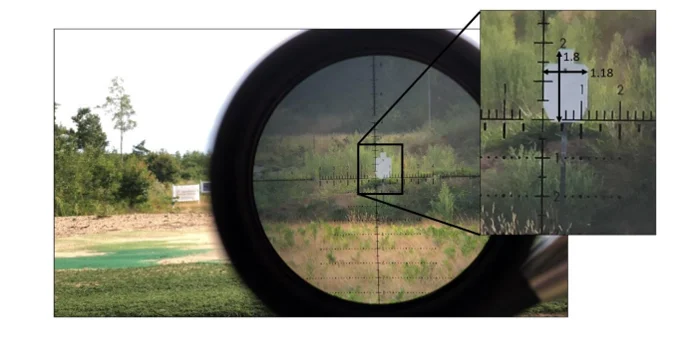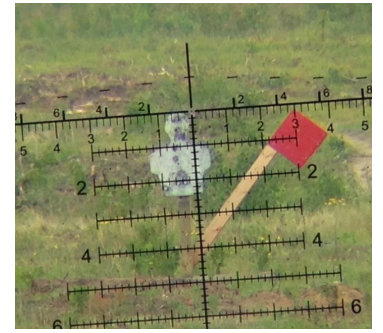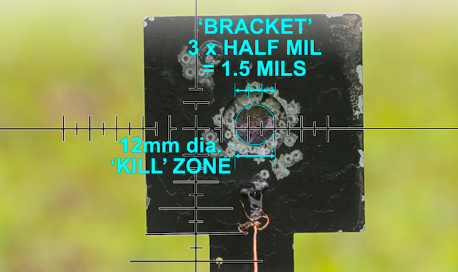Estimating Distance with Your Rifle Scope Reticle
One of the most valuable skills a shooter can develop is the ability to estimate distance to a target - especially when shooting at unknown ranges. Many rifle scopes are equipped with reticles specifically designed to help with this task. These reticles often include hash marks, dots, or lines (known as subtensions) that correspond to specific measurements, usually in MOA (Minutes of Angle) or MRAD (milliradians).
By knowing the size of the target and using the markings on your reticle, you can perform simple calculations to estimate range with surprising accuracy, but it is important to remember that it is an estimation, however and not as accurate as a laser rangefinder, but generally it is accurate within about 5%. This technique is widely used in both hunting and long-range shooting, where accurate distance estimation is critical for proper bullet drop compensation and first-shot hits. Whether you're using a standard mil-dot reticle or a more advanced grid-style design, learning how to range targets with your scope adds a powerful tool to your shooting toolbox.
How to Estimate Distance Using Your Reticle
The calculation required for this is pretty simple, especially if you have an MRAD scope.
Distance (meters)= Target size (cm) x 10 divided by the Mils
Distance (yards) = Target size (inches) x 27.78 divided by the Mils
Target size: The height or the width of the target.
Mils: The number of Mils (milliradians) the target spans in your reticle.
27.78: Conversion constant to get yards when using inches and mils.
For example, let's range a 66% IPSC target.

This target is actually at 269.75m or 295yds.
These targets are 20" by 12" or 30.48cm by 50.8cm.
Let's do an estimate in metres first.
Seeing as we know the size of the target, we now need to see the amount of Mils it spans.
This unit spans 1.8mils up and 1.18mils across.
30.48cm (width) x 10 divided by 1.18 mils across = 258.3 metres.
50.8cm (height) x 10 divided by 1.8mil up = 282.2 metres.
You'll notice these two measurements are different; this is because estimating the mil in the scope will affect the measurement the calculation gives you.
It also shows how this is more of an estimation rather than the precision a laser rangefinder provides.
Let's try rounding it to 2Mil elevation and see what happens
50.8 x 10 divided by 2mil up = 254 metres.
Now we have another measurement again, which shows how important it is to know the size of the target and how a small variation on the Mil will alter your results.
An easy way to get the best measurement is to add both measurements (height and width) together and divide them to get an average.
258.3m + 282.2m divided by 2 = 270.25 metres.
Let's try measuring yards with the same scope.
12" (width) x 27.78 divided by 1.18mils across = 282.5 yards
20" (height) x 27.78 divided by 1.8mils up = 308.6 yards
With these two measurements being different, let's get an average.
282.5 + 308.6 divided by 2 = 295.55yds.
With an MOA scope, the use is less common for ranging, but still possible.
The calculation is:
Distance (yards) = Target size (inches) x 95.5 divided by the MOA the target covers in the reticle.
The 95.5 constant comes from how MOA works (1 MOA = 1.047 inches at 100yards.)
An example of this would be an 18" across by 24" high target.

With this target, we know the sizes. Let's work out the distance.
18" (width) x 95.5 divided by 1.8moa (approx. size of target in reticle) = 955yards
24" (height) x 95.5 divided by 2.4moa (approx. size of target in reticle) = 955yards
Shortening the method (MRAD ONLY)
Once we get used to doing this math quickly, we can shorten it to,
Distance (metres) = Target size (Millimetres) divided by Mils.
For example, the first target, 508mm (height) divided by 1.8mils = 282.2 metres.
This method is popular in Field Target and Hunter Field Target competitions, where speed is of the essence.

With this example, it would be 12mm (width or height) divided by 1.5mils.
This target is 8 metres away.
Tips for Better Accuracy
- The more precisely you can measure how many mils or MOA the target spans in your reticle, the more accurate your range estimate will be.
- Use a range card or cheat sheet with common target sizes (like deer, torso targets, or steel plates).
- Many scopes with first focal plane (FFP) reticles allow accurate ranging at any magnification, while second focal plane (SFP) scopes usually require you to range at a specific zoom level (typically max power).
The more precisely you can measure how many mils or MOA the target spans in your reticle, the more accurate your range estimate will be. Use a range card or cheat sheet with common target sizes (like deer, torso targets, or steel plates). Many scopes with first focal plane (FFP) reticles allow accurate ranging at any magnification, while second focal plane (SFP) scopes usually require you to range at a specific zoom level (typically max power).






